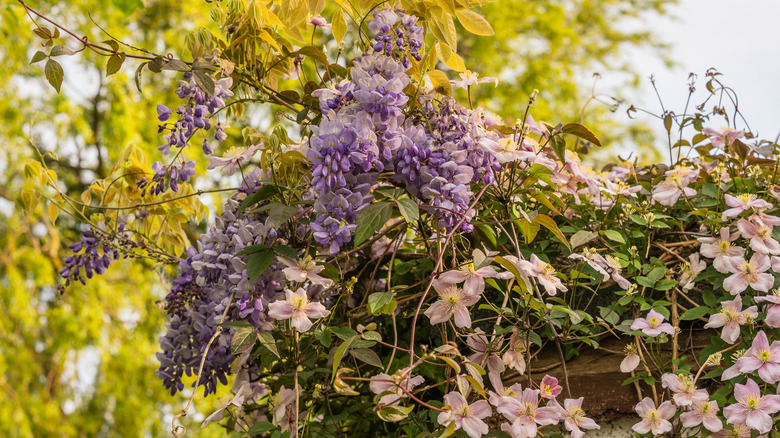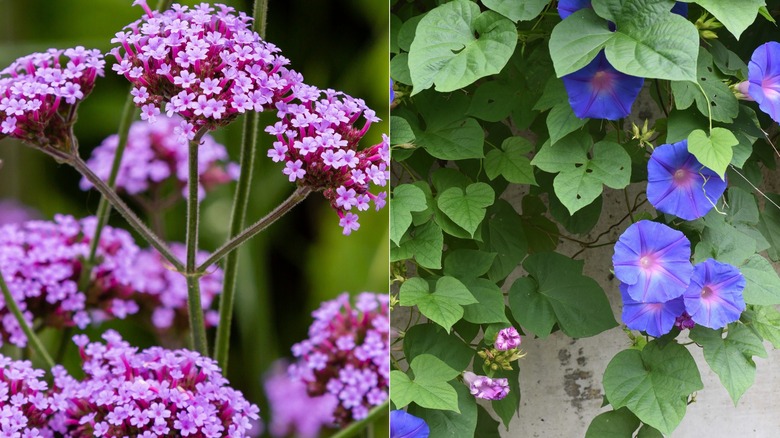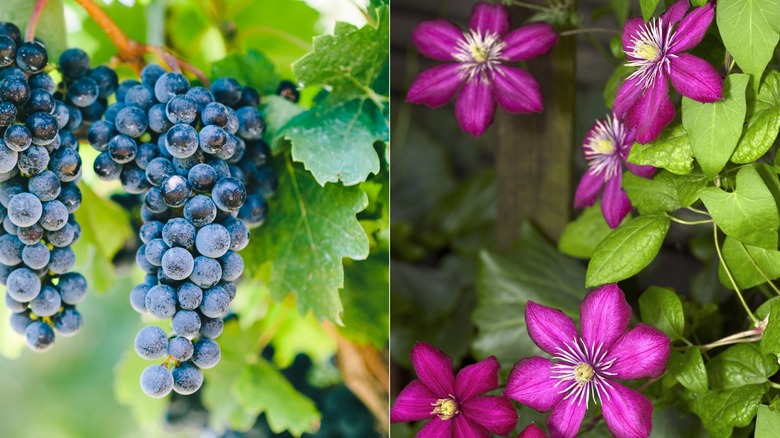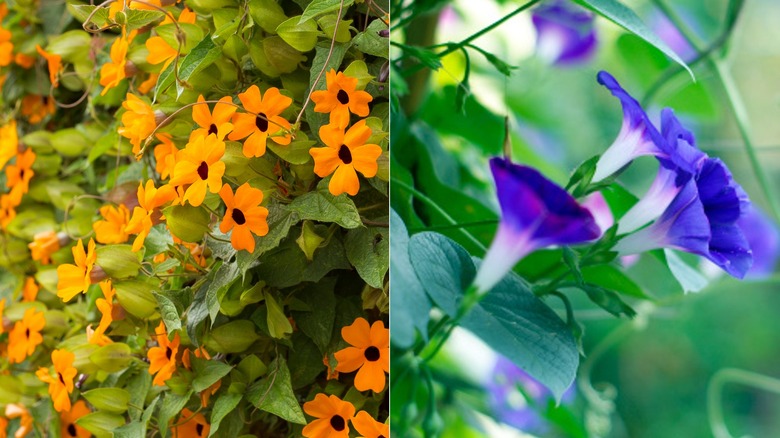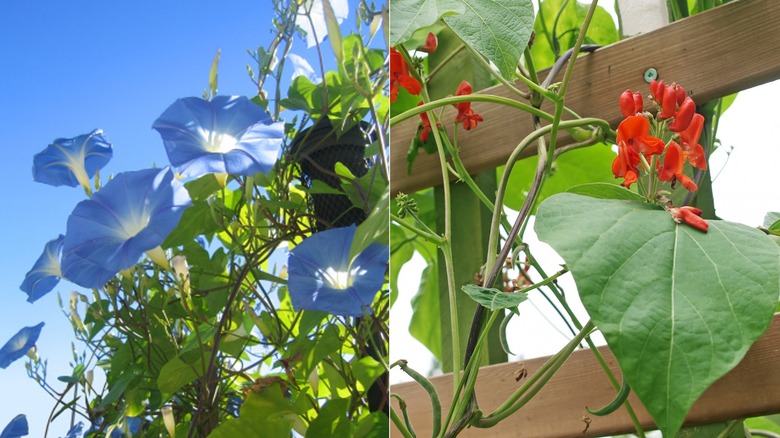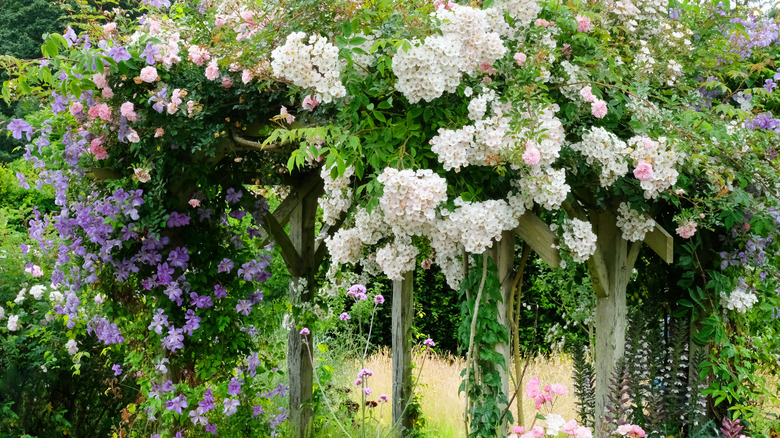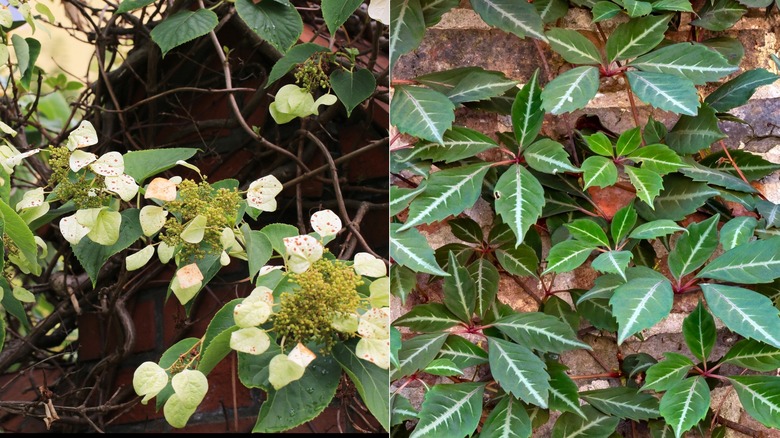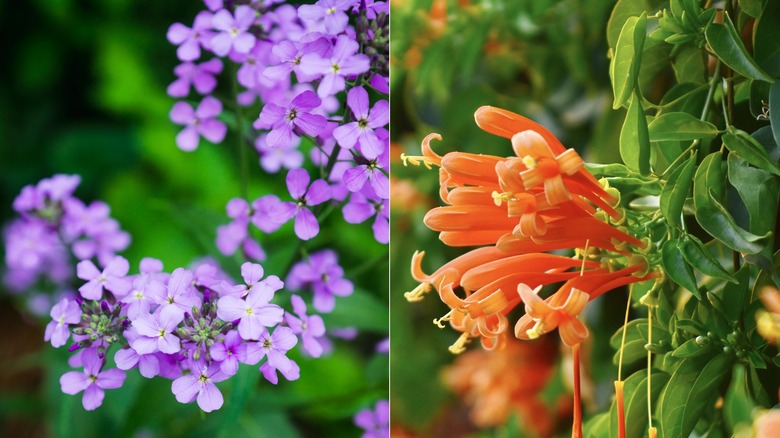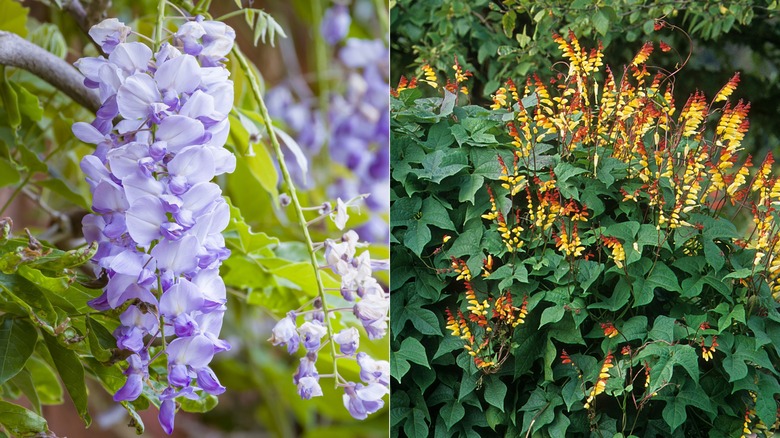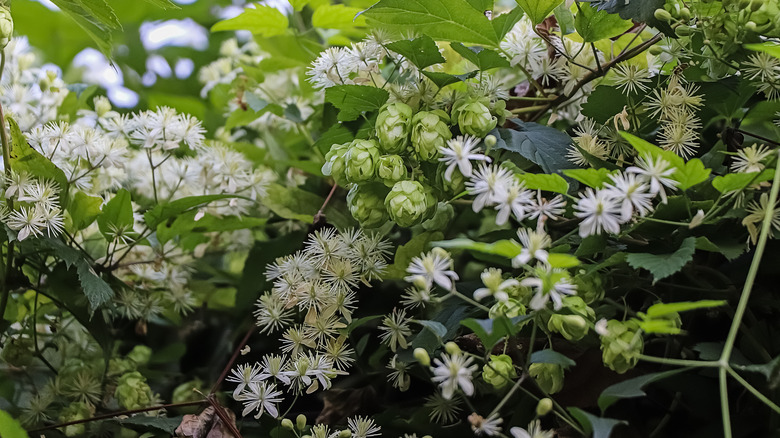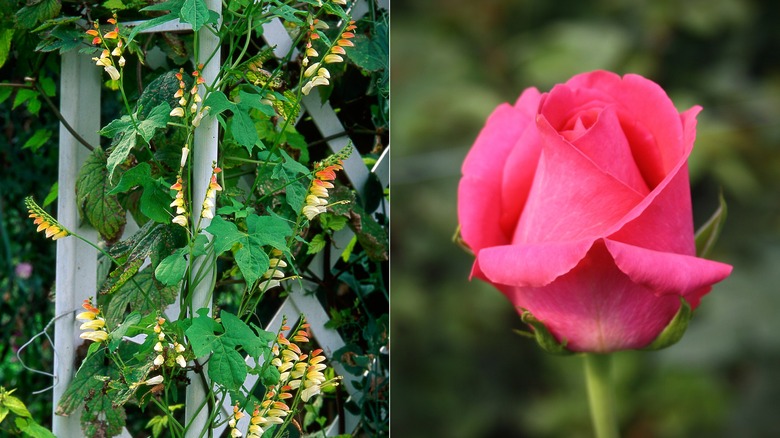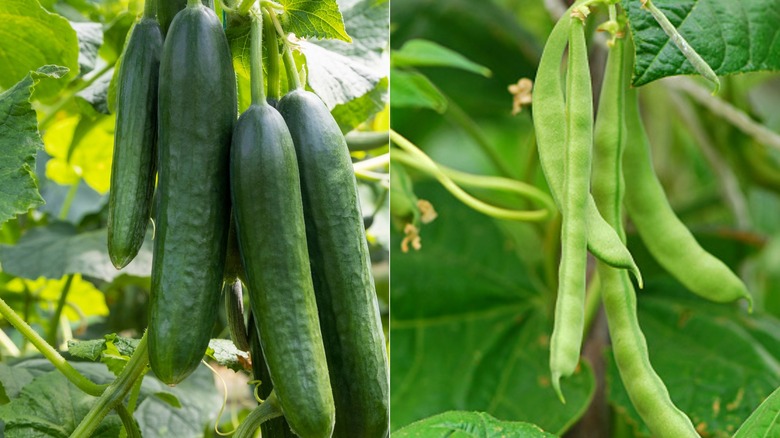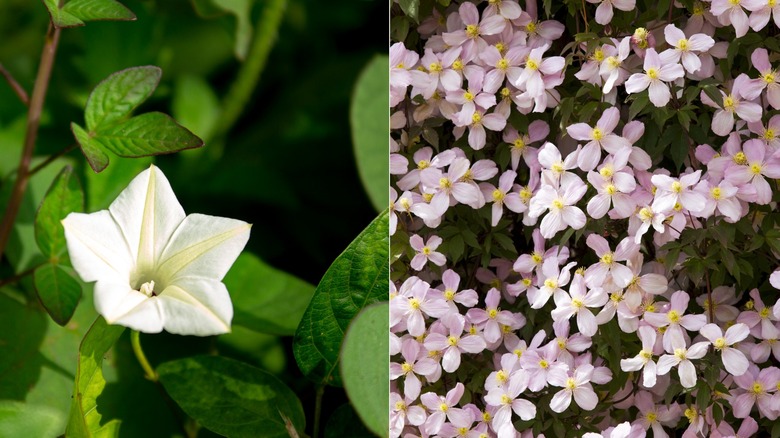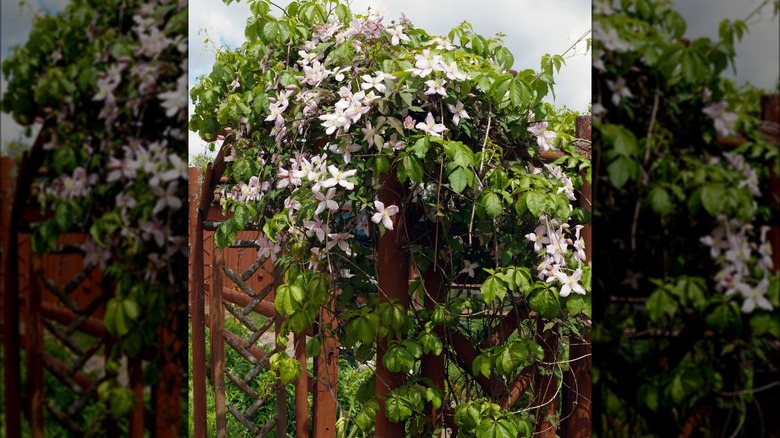The Best Climbing Plant Pairings For Your Garden
Climbing vines tend to be some of the easiest to grow and most versatile plants out there. Grown in the garden, twining species such as wisteria, morning glories, ivies, pole beans, and more use their specific strengths to help one another as they spread. You can choose to have them decorate a small hanging basket with multicolored flowers or allow them to climb across a large wall or trellis to really make a statement.
You should keep in mind, however, that most climbing plants have different growing requirements that need to be met. Trying to plant a vine that likes staying dry and cool alongside another that naturally grows in tropical rainforests will end badly. Do your best to choose two vines that enjoy the same sunlight, soil, temperature, and watering needs so that you can easily keep both alive. Grown in the right sort of conditions, your creepers, climbers, and twiners will branch out rapidly and produce loads of attractive leaves and flowers. If you prefer to skip all that research on the countless species of vining plants there are to choose from, read on to find the best vine pairs for your garden.
1. Verbena and morning glory vine
When pairing two vining plants, as mentioned previously, we need to consider their growing requirements first. We want them to be as similar as possible so that both climbers can get the nutrients and moisture they need to survive. A good example of this is the morning glory vine (Ipomoea purpurea) paired with trailing verbena (Glandularia canadensis). These vines both grow best in loamy and well-draining soil that receives direct sunlight. As a bonus, they also both begin blooming in the spring for a gorgeous display of many flowers in shades of purple.
2. Grape vine and leather flowers
The popularly grown leather flower (Clematis spp.), which is also known simply as Clematis, grows well alongside the common grapevine (Vitis vinifera). Just like the previous pair, they share similar growing preferences such as well-draining soil and partial shade. People particularly enjoy planting these two together for the grapevine's attractive foliage and the clematis's bright blossoms that bloom in the spring, summer, and fall seasons. When these plants climb and twist together their ornamental value appears to double.
3. Virginia creeper and wisteria vine
Though the Virginia creeper (Parthenocissus quinquefolia) can withstand growing in heavy shade for some time, it's best kept in direct sunlight and partnered with Wisteria (Wisteria spp.). These two climbing plants are spring bloomers that get along nicely as long as the more finicky Wisteria species are placated with their preferred growing conditions. This includes planting the two in somewhat acidic, humusy, fertile, evenly moist, and well-drained soil as well as providing regular watering, fertilization, and pruning. Though the maintenance can be intense, you won't regret growing these flowering vines together.
4. Black-eyed Susan vine and morning glory
Most gardeners are familiar with the morning glory (Ipomoea purpurea) and black-eyed Susan vines (Thunbergia alata). These easy-going and widely-favored climbing flowers are known for their long-lasting blooms that last the entire growing season and their need for warm temperatures. In most places, the two vines are annuals that are used ornamentally in home gardens. Despite their short lifespan, however, morning glory and black-eyed Susan vines shoot up and produce countless blooms surrounded by thick foliage in no time. They'll quickly brighten a dull landscape and require very little help to do so.
5. Blue dawn flower and scarlet runner bean
The blue dawn flower (Ipomoea indica), which is a species in the morning glory family, may be paired with an unexpected vining plant: scarlet runner beans (Phaseolus coccineus). If you've ever grown beans in your vegetable garden, you might notice that scarlet runner beans' uncanny resemblance to the pole bean. This is because they are of the same species. One is simply for ornamental use while the other is a crop. Partnered with the blue dawn flower, the two plants attract pollinators like hummingbirds and bees that love their colorful blooms.
6. Climbing roses and Jackman's clematis
If you live in a colder or more temperate climate, climbing roses (Rosa setigera) and Jackman's clematis (Clematis x jackmanii) might be the vines for you. The perennial plants need only well-draining cool soil, direct sunlight, and regular watering to thrive. Each of the flowering creepers blooms in the summer and grows to about 15 feet tall. When cared for properly, they will continue to mature and flower for a number of years.
7. Moonlight hydrangea and silver vein creeper
A member of the grape family, the silver vein creeper (Parthenocissus henryana) sports green to red foliage with silvery veining, hence its common name. Using its disk-shaped suckers, this climbing plant can reach up to 20 feet long. Similarly, the moonlight hydrangea (Hydrangea hydrangeoides 'Moonlight') uses disk-like aerial rootlets to hang its stems filled with silvery leaves and fragrant white flowers. Together, these two climbers will literally shine in a moon garden as they twine around a metal arch or creep up an old wall.
8. Dame's rocket and trumpet honeysuckle
Two climbing plants known for their low-maintenance habits are the trumpet honeysuckle (Lonicera sempervirens) and Dame's rocket (Hesperis matronalis). Both of them are perennial vines without any major pest or disease risks, and they aren't too picky about their soil. They are well-suited to growing in USDA zones 3 to 9, particularly on the United States East Coast, where they both have naturalized. Due to their quickly spreading nature, the two climbers should be watched carefully and pruned often to avoid becoming too weedy.
9. Japanese wisteria and Spanish flag
Japanese wisteria (Wisteria floribunda) and Spanish flag (Ipomoea lobata) make a good match when grown as annuals on a trellis. While the Spanish flag prefers evenly moist and rich soil, this wisteria can grow in wet or dry soil. In fact, Japanese wisteria is capable of adapting to many of the Ipomoea species' needs. You shouldn't assume wisteria is low-maintenance, however, due to its aggressive growth habit it requires frequent attention and pruning. The Spanish flag vine is much easier to care for as it establishes itself quickly when its growth requirements are met.
10. Golden hops and traveler's joy clematis
The golden hops plant (Humulus lupulus 'Aureus') is known for its use in flavoring beer. This specific variety is often grown ornamentally for its chartreuse foliage and flowers which makes it a lovely specimen in the garden. Its green cone-shaped flowers go nicely with the small white blooms of traveler's joy (Clematis vitabla). Trained onto an unattractive fence or other structure, these flowering vines will twine and climb until the support is unrecognizable under the plants' foliage.
11. Mme. Grégoire Staechelin rose and fire vine
Even climbing roses can have companions. The Mme. Grégoire Staechelin rose (Rosa 'Madame Grégoire Staechelin') and fire vine (Ipomoea lobata) grow well together and create a spectacular show during the warmer season. The pink blooms of the climbing roses look stunning beside the smaller red-yellow flowers of the fire vine. Make sure to plant the two in plenty of sunlight and provide their rich and well-draining soil with consistent moisture.
12. Runner beans and cucumbers
Flowering and ornamental vines aren't the only climbers that you can pair together. Vegetable plants like runner beans (Phaseolus coccineus) and cucumbers (Cucumis sativus) may also cohabitate in the garden. These two plants can climb trellises and look quite good when grown side by side, but the reason we recommend keeping them together is below the ground. Runner beans are known to fix nitrogen in their roots and release it into the soil, which helps the cucumber vine grow properly.
13. Moonflowers and clematis
Moonflowers (Ipomoea alba) are a part of the same genus as some other popular climbing plants on this list including morning glories, blue dawn flowers, and Spanish flag vines. The genus is known for its many eye-catching blooms that are typically borne on twining climbing plants. Paired with clematis (Clematis spp.), another genus of vines that frequently produce brightly colored flowers, the two create a beacon for pollinators and other beneficial insects.
14. Anemone clematis and Boston ivy
Another clematis species, anemone clematis (Clematis montana) is a widely-spreading vine that can reach 50 feet tall. Yet, its best partner, Boston ivy (Parthenocissus tricuspidata), may become even larger as it frequently measures up to 60 feet long. These two overgrown climbers make a wonderful pair if you are trying to cover a fairly large wall or trellis with white blooms and ivy-like foliage. They both thrive with regular watering and direct sunlight.
